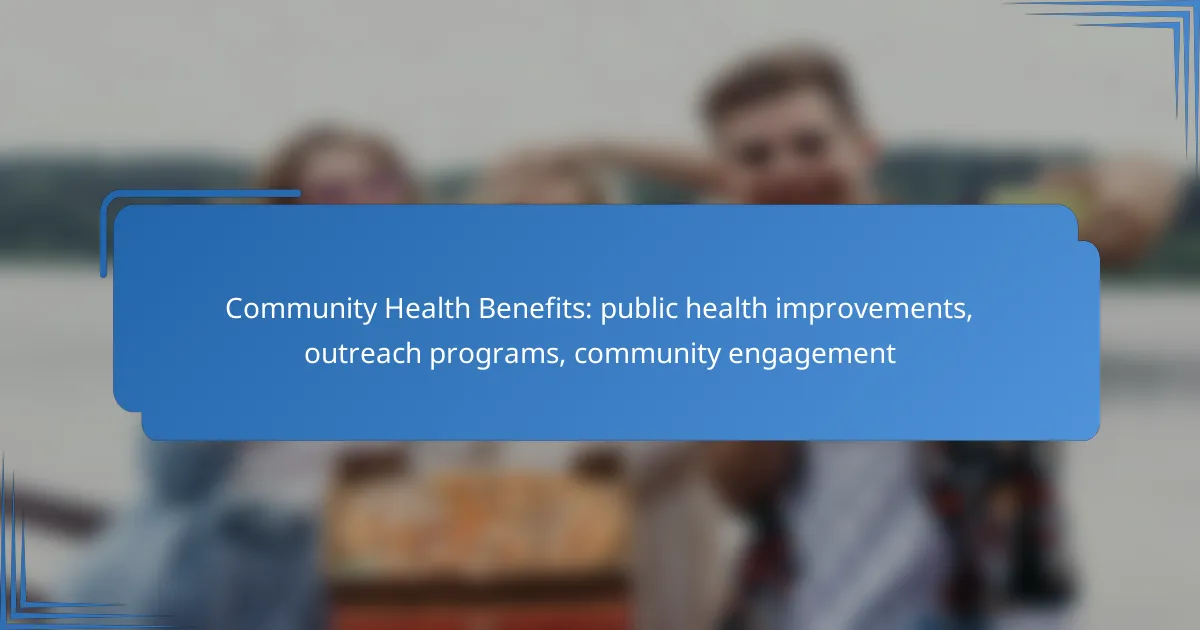Community health benefits are crucial for enhancing public health through preventive care and increased health literacy. By implementing targeted outreach programs and fostering community engagement, these initiatives address health disparities and promote overall well-being. Collaborative efforts among local organizations, healthcare providers, and residents ensure that health resources are accessible and relevant to the community’s specific needs.

How do community health programs improve public health in Australia?
Community health programs in Australia enhance public health by promoting preventive care, increasing health literacy, and fostering community engagement. These initiatives aim to address health disparities and improve overall well-being through targeted outreach and support services.
Reduction in chronic disease rates
Community health programs play a crucial role in reducing chronic disease rates by focusing on prevention and early intervention. By providing education on healthy lifestyles, such as nutrition and physical activity, these programs help individuals make informed choices that can lower their risk of conditions like diabetes and heart disease.
For example, initiatives that offer free or low-cost health screenings can identify risk factors early, allowing for timely management and treatment. This proactive approach can lead to a significant decrease in the prevalence of chronic diseases within communities.
Increased access to healthcare services
Improving access to healthcare services is a fundamental aspect of community health programs. These programs often establish partnerships with local clinics and hospitals to provide services in underserved areas, ensuring that more individuals receive the care they need.
Mobile health units and telehealth services are examples of how community programs can bridge gaps in access. By bringing healthcare directly to communities or utilizing technology, they can effectively reach populations that may otherwise face barriers to care, such as transportation issues or financial constraints.
Enhanced mental health support
Community health programs also focus on enhancing mental health support, recognizing its critical role in overall health. These initiatives often provide resources such as counseling, support groups, and educational workshops aimed at reducing stigma and promoting mental well-being.
For instance, programs that offer peer support can create safe spaces for individuals to share their experiences and challenges. This communal approach not only fosters resilience but also encourages individuals to seek help when needed, ultimately leading to improved mental health outcomes across the community.

What outreach programs are effective in Australian communities?
Effective outreach programs in Australian communities focus on improving public health through targeted initiatives that engage residents and address specific health needs. These programs often involve collaboration between local organizations, healthcare providers, and community members to ensure accessibility and relevance.
Healthy Communities Initiative
The Healthy Communities Initiative aims to enhance the overall health of communities by promoting active living and healthy eating. This program typically involves local governments and health organizations working together to create environments that support physical activity, such as parks and walking paths.
Key components include community workshops, fitness events, and nutrition education sessions. By fostering a culture of health, these initiatives can lead to long-term improvements in community well-being.
Community Health Worker Programs
Community Health Worker (CHW) programs train individuals from within the community to provide health education and support. These workers act as liaisons between healthcare providers and residents, helping to bridge gaps in access to services.
CHWs can assist with navigating the healthcare system, providing information on preventive care, and addressing social determinants of health. Their local knowledge and trust within the community enhance the effectiveness of health outreach efforts.
School-based health education
School-based health education programs focus on teaching children about healthy lifestyles, nutrition, and physical activity. These programs often integrate health topics into the school curriculum and may include hands-on activities, such as cooking classes or fitness challenges.
Engaging students early helps instill lifelong health habits. Collaborating with parents and the community can further reinforce these lessons, creating a supportive environment for children’s health development.

How can community engagement enhance health outcomes?
Community engagement can significantly enhance health outcomes by fostering active participation and collaboration among residents, healthcare providers, and local organizations. This collective effort leads to improved access to health resources, better health education, and a stronger support system for individuals.
Increased participation in health screenings
Engaging the community in health initiatives often results in higher participation rates in health screenings. When local organizations promote these screenings, they can reach underserved populations who might otherwise avoid them due to lack of awareness or access.
For example, community health fairs that offer free screenings for conditions like diabetes or hypertension can draw in hundreds of participants. Providing incentives such as free meals or health education sessions can further boost attendance.
Stronger local health networks
Community engagement helps build stronger local health networks by connecting individuals with healthcare providers and resources. These networks facilitate information sharing and collaboration among various stakeholders, including hospitals, clinics, and non-profits.
Regular meetings and events can strengthen these relationships, allowing for coordinated efforts in addressing public health challenges. For instance, a coalition of local health organizations can work together to tackle issues like obesity or substance abuse more effectively.
Improved health literacy
Community engagement initiatives often focus on improving health literacy, which is crucial for making informed health decisions. Programs that provide education on topics such as nutrition, preventive care, and chronic disease management empower individuals to take control of their health.
Workshops, informational pamphlets, and online resources can be tailored to the specific needs of the community, ensuring that information is accessible and relevant. For example, bilingual materials can help reach diverse populations, enhancing overall understanding and engagement.

What criteria should be considered for selecting community health initiatives?
Selecting community health initiatives requires careful consideration of various criteria to ensure effectiveness and sustainability. Key factors include understanding the needs of the target population, assessing available funding and resources, and identifying potential partnership opportunities.
Target population needs
Understanding the needs of the target population is crucial for selecting effective community health initiatives. Conduct surveys, focus groups, or community assessments to gather data on health issues, demographics, and preferences. This information helps tailor programs to address specific challenges faced by the community.
For example, if a community struggles with high rates of diabetes, initiatives could focus on nutrition education and physical activity programs. Prioritizing the most pressing health concerns ensures that resources are allocated effectively.
Available funding and resources
Assessing available funding and resources is essential for the sustainability of community health initiatives. Identify potential funding sources, including government grants, local foundations, and corporate sponsorships. Understanding budget constraints will help in planning realistic and achievable programs.
Consider leveraging existing resources, such as local health facilities or volunteers, to maximize impact without incurring significant costs. A well-prepared budget that outlines expected expenses and funding sources can enhance the initiative’s viability.
Partnership opportunities
Identifying partnership opportunities can significantly enhance the effectiveness of community health initiatives. Collaborating with local organizations, healthcare providers, and educational institutions can provide additional resources, expertise, and outreach capabilities. These partnerships can also help in sharing costs and responsibilities.
For instance, a local health department might partner with schools to implement health education programs, reaching a wider audience while utilizing shared facilities. Building strong relationships with stakeholders fosters a collaborative environment that can lead to more successful health outcomes.

What are the unique challenges faced by community health programs in Australia?
Community health programs in Australia encounter several unique challenges that can hinder their effectiveness. These include geographic disparities in access to services, the need for cultural sensitivity and inclusivity, and limitations in funding that affect program sustainability.
Geographic disparities in access
Geographic disparities significantly impact access to community health services in Australia, particularly in rural and remote areas. Many communities face long distances to healthcare facilities, which can deter individuals from seeking necessary care.
To address these disparities, programs can utilize mobile health units or telehealth services, making healthcare more accessible. Collaborating with local organizations can also help bridge the gap by providing outreach and education tailored to specific communities.
Cultural sensitivity and inclusivity
Cultural sensitivity and inclusivity are crucial for the success of community health programs in Australia, given the country’s diverse population. Programs must respect and understand the cultural backgrounds of various communities to effectively engage and serve them.
Incorporating culturally appropriate practices and involving community leaders in program design can enhance trust and participation. Training staff on cultural competence is also essential to ensure respectful and effective communication with all community members.
Funding limitations
Funding limitations pose a significant challenge for community health programs in Australia, often restricting their ability to expand services or maintain existing programs. Many initiatives rely on government grants and donations, which can be inconsistent and competitive.
To mitigate funding issues, programs should explore diverse funding sources, including partnerships with private organizations and community fundraising efforts. Developing a clear budget and demonstrating program impact can also help attract and retain funding support.

What emerging trends are shaping community health in Australia?
Emerging trends in community health in Australia are increasingly focused on technology integration, data utilization, and preventive care strategies. These trends aim to enhance public health outcomes through innovative outreach programs and community engagement initiatives.
Telehealth integration
Telehealth integration is revolutionizing how healthcare services are delivered in Australia, making them more accessible to remote and underserved populations. Patients can now consult healthcare professionals via video calls or online platforms, reducing travel time and associated costs.
This trend is particularly beneficial for individuals with chronic conditions who require regular monitoring. Telehealth services can include virtual check-ups, mental health support, and even remote monitoring of vital signs, ensuring continuity of care.
Data-driven health interventions
Data-driven health interventions leverage analytics to identify health trends and target specific community needs. By analyzing health data, organizations can design tailored programs that address prevalent issues such as obesity, mental health, and substance abuse.
For example, local health departments may use data to pinpoint areas with high rates of diabetes and implement community workshops focused on nutrition and exercise. This targeted approach can lead to more effective health outcomes and resource allocation.
Focus on preventive care
A growing emphasis on preventive care is reshaping community health strategies in Australia. Programs aimed at prevention, such as vaccination drives and health screenings, are crucial for reducing the incidence of diseases and improving overall public health.
Communities are encouraged to participate in regular health assessments and educational campaigns that promote healthy lifestyles. For instance, initiatives that provide free health check-ups and workshops on nutrition can significantly decrease long-term healthcare costs and improve quality of life.
